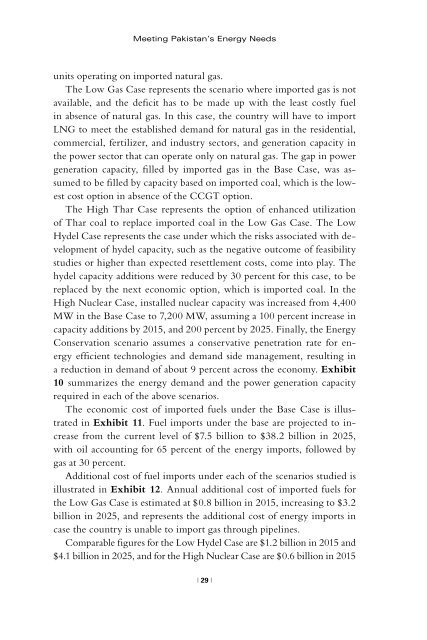fueling the future - Woodrow Wilson International Center for Scholars
fueling the future - Woodrow Wilson International Center for Scholars
fueling the future - Woodrow Wilson International Center for Scholars
- No tags were found...
Create successful ePaper yourself
Turn your PDF publications into a flip-book with our unique Google optimized e-Paper software.
Meeting Pakistan’s Energy Needsunits operating on imported natural gas.The Low Gas Case represents <strong>the</strong> scenario where imported gas is notavailable, and <strong>the</strong> deficit has to be made up with <strong>the</strong> least costly fuelin absence of natural gas. In this case, <strong>the</strong> country will have to importLNG to meet <strong>the</strong> established demand <strong>for</strong> natural gas in <strong>the</strong> residential,commercial, fertilizer, and industry sectors, and generation capacity in<strong>the</strong> power sector that can operate only on natural gas. The gap in powergeneration capacity, filled by imported gas in <strong>the</strong> Base Case, was assumedto be filled by capacity based on imported coal, which is <strong>the</strong> lowestcost option in absence of <strong>the</strong> CCGT option.The High Thar Case represents <strong>the</strong> option of enhanced utilizationof Thar coal to replace imported coal in <strong>the</strong> Low Gas Case. The LowHydel Case represents <strong>the</strong> case under which <strong>the</strong> risks associated with developmentof hydel capacity, such as <strong>the</strong> negative outcome of feasibilitystudies or higher than expected resettlement costs, come into play. Thehydel capacity additions were reduced by 30 percent <strong>for</strong> this case, to bereplaced by <strong>the</strong> next economic option, which is imported coal. In <strong>the</strong>High Nuclear Case, installed nuclear capacity was increased from 4,400MW in <strong>the</strong> Base Case to 7,200 MW, assuming a 100 percent increase incapacity additions by 2015, and 200 percent by 2025. Finally, <strong>the</strong> EnergyConservation scenario assumes a conservative penetration rate <strong>for</strong> energyefficient technologies and demand side management, resulting ina reduction in demand of about 9 percent across <strong>the</strong> economy. Exhibit10 summarizes <strong>the</strong> energy demand and <strong>the</strong> power generation capacityrequired in each of <strong>the</strong> above scenarios.The economic cost of imported fuels under <strong>the</strong> Base Case is illustratedin Exhibit 11. Fuel imports under <strong>the</strong> base are projected to increasefrom <strong>the</strong> current level of $7.5 billion to $38.2 billion in 2025,with oil accounting <strong>for</strong> 65 percent of <strong>the</strong> energy imports, followed bygas at 30 percent.Additional cost of fuel imports under each of <strong>the</strong> scenarios studied isillustrated in Exhibit 12. Annual additional cost of imported fuels <strong>for</strong><strong>the</strong> Low Gas Case is estimated at $0.8 billion in 2015, increasing to $3.2billion in 2025, and represents <strong>the</strong> additional cost of energy imports incase <strong>the</strong> country is unable to import gas through pipelines.Comparable figures <strong>for</strong> <strong>the</strong> Low Hydel Case are $1.2 billion in 2015 and$4.1 billion in 2025, and <strong>for</strong> <strong>the</strong> High Nuclear Case are $0.6 billion in 2015| 29 |
















